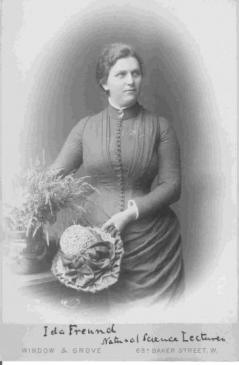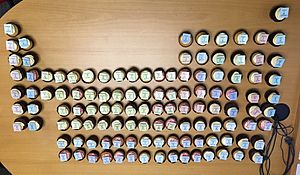Ida Freund facts for kids
Quick facts for kids
Ida Freund
|
|
|---|---|
 |
|
| Born | 15 April 1863 Austria
|
| Died | 15 May 1914 (aged 51) Cambridge, England
|
| Nationality | Austrian |
| Alma mater | University of Cambridge (BA) |
| Occupation | Chemistry lecturer |
| Known for | Science education |
|
Notable work
|
The Study of Chemical Composition (1904), The Experimental Basis of Chemistry (1920) |
Ida Freund (born April 15, 1863 – died May 15, 1914) was an amazing scientist. She was the very first woman to teach chemistry at a university in the United Kingdom. Ida is famous for changing how science was taught, especially for girls and women. She wrote important chemistry books. She also came up with the fun idea of making periodic table cupcakes! Plus, she invented a special tube for measuring gas, which was named after her.
Contents
Ida Freund's Life Story
Ida Freund was born in Austria. When her mother passed away, Ida went to live with her grandparents in Vienna. In 1881, her grandparents also died. So, she moved to England to live with her uncle, Ludwig Straus. He was a famous violinist.
Ida started studying at Girton College in Cambridge. Even though she didn't know much English before, she did really well! She earned top grades in the Natural Sciences course. After that, she became a chemistry teacher at the Cambridge Training College for Women. A year later, she joined Newnham College, Cambridge as a demonstrator.
In 1890, Ida became a staff lecturer in chemistry at Newnham College. This was a huge step! She was the first woman ever to be a full chemistry lecturer in the UK. She also became a member of the college's council.
Teaching and Challenges
Ida loved teaching, so she didn't spend much time on research. She didn't get a master's degree or a doctorate. She was in charge of teaching her students how to work in the lab. Many students came to college knowing very little about chemistry.
Her students thought she was an inspiring teacher. Ida had lost a leg in a cycling accident when she was younger. She used walking sticks, a fake leg, or a special tricycle wheelchair that she worked with her arms. Her unique style and disability made her stand out. People often talked about her.
Ida was also a strong supporter of women's suffrage, which meant she believed women should have the right to vote. She was one of the women who fought to join the Chemical Society in the early 1900s. Women were finally allowed to join in 1920, but sadly, Ida had passed away six years before.
Ida stayed at Newnham College until 1913, when she retired because she was unwell. After she retired, the chemistry lab at Newnham closed. This was because by then, female students could study in the main university chemistry labs. Ida died on May 15, 1914, in Cambridge. She was working on her second book when she passed away after surgery.
Ida's Teaching Style
Ida Freund is well-known for her passion for science education. She especially wanted to make science teaching better in girls' schools. Back then, women in Cambridge couldn't work in the same labs as men. So, Ida taught special classes in the chemistry labs at Newnham College, Cambridge. She also wrote textbooks and held workshops during holidays for women teachers.
Ida tried out different ways of teaching. She liked Wilhelm Ostwald's method, where chemistry facts were taught through a conversation between a teacher and a student. She also made her students read original science papers and check if the published work was correct. This was a very new idea at the time, and some people criticized her for it. However, she had a big impact on teaching methods and her students loved her.
The people who edited her book, The Fundamental Principles of Chemistry, said that Ida didn't like careless experiments or sloppy thinking. They quoted her saying, "I wanted to give students not just knowledge, but also a clear idea of what scientific proof means and what real accuracy is."
Ida didn't think that teaching cooking (domestic science) should replace real science education for girls. But she used her own baking skills to create fun teaching tools!
Periodic Table Cupcakes
Ida Freund was the first person to bake a set of periodic table cupcakes! She used them to help her students learn in the classroom. She made boxes of chocolates with pictures of scientists. She also created a large periodic table where each element was a cupcake. The cupcakes were decorated with the element's name and atomic number in icing.
One of her students described how it worked:
In my year we were asked to study the 'Periodic Table of the Elements' more closely. We found a very big board with the Table set out. The lines were made with Edinburgh Rock, numbers were made of chocolate, and the elements were iced cakes. Each cake showed its name and atomic weight in icing. The elements with no bonding power were round. Elements with one bonding power had a corner sticking out, two bonding powers had two corners, three bonding powers were triangular, and so on. We ate it all up among ourselves!
Thanks to Ida's original idea, periodic table cupcakes are now a popular and fun way to celebrate chemistry. You can find them at school bake sales and events that want to get people interested in science. The Royal Society of Chemistry even celebrated the launch of their Visual Elements Periodic Table with periodic table cupcakes. Students at Nottingham University did the same for Professor Martyn Poliakoff's birthday. A video of these cakes is part of Professor Poliakoff's online series, 'Periodic Videos', which aims to teach chemistry to new students.
You can find recipes online to make your own modern versions of Ida Freund's periodic table cupcakes.
Ida's Inventions
Besides inventing periodic table cupcakes, Ida Freund also had a piece of lab equipment named after her. It was a tube used for measuring gas. This invention is not used much anymore.
Remembering Ida Freund
In April 1998, the lab at Newnham College was restored to honor Ida Freund. The Ida Freund Memorial Fund was also set up. Its goal is to help women science teachers get more training and improve their skills. Newnham College also gives out the Ida Freund Memorial Prize. And Girton College gives the Ida Freund Prize to its top physical science students for their excellent academic work.
See also
 In Spanish: Ida Freund para niños
In Spanish: Ida Freund para niños


